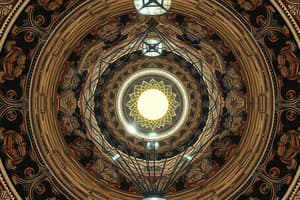Podcast
Questions and Answers
What type of image do convex mirrors always produce?
What type of image do convex mirrors always produce?
- Virtual and upright (correct)
- Real and inverted
- Virtual and inverted
- Real and upright
Which application is most suitable for concave mirrors?
Which application is most suitable for concave mirrors?
- Rearview mirrors in cars
- Traffic monitoring at intersections
- Security mirrors in shops
- Shaving mirrors for magnification (correct)
What determines the type of image formed by a concave mirror?
What determines the type of image formed by a concave mirror?
- The position of the object relative to the mirror (correct)
- The size of the mirror
- The shape of the object being reflected
- The material of the mirror
What is a characteristic trait of images formed by convex mirrors?
What is a characteristic trait of images formed by convex mirrors?
Which type of spherical mirror would be most effective in a solar furnace?
Which type of spherical mirror would be most effective in a solar furnace?
If an object is placed between the pole and the focus of a concave mirror, what type of image is formed?
If an object is placed between the pole and the focus of a concave mirror, what type of image is formed?
What is the main advantage of using convex mirrors as rearview mirrors in vehicles?
What is the main advantage of using convex mirrors as rearview mirrors in vehicles?
What is the main role of the focal point in the image formation of concave mirrors?
What is the main role of the focal point in the image formation of concave mirrors?
Reflection of light
Reflection of light
Explain how the focal length of a concave mirror is related to its radius of curvature.
Explain how the focal length of a concave mirror is related to its radius of curvature.
Describe the image characteristics produced by a convex mirror.
Describe the image characteristics produced by a convex mirror.
What is the significance of the reflecting surface location in concave mirrors?
What is the significance of the reflecting surface location in concave mirrors?
How does the curvature of a mirror affect the behavior of light rays in concave and convex mirrors?
How does the curvature of a mirror affect the behavior of light rays in concave and convex mirrors?
What are some common applications of concave mirrors, and why are they suitable for these uses?
What are some common applications of concave mirrors, and why are they suitable for these uses?
Flashcards
Concave Mirror
Concave Mirror
A spherical mirror with a reflecting surface that curves inward.
Convex Mirror
Convex Mirror
A spherical mirror with a reflecting surface that curves outward.
Real Image
Real Image
An image that can be projected onto a screen.
Virtual Image
Virtual Image
Signup and view all the flashcards
Focal Point
Focal Point
Signup and view all the flashcards
Center of Curvature
Center of Curvature
Signup and view all the flashcards
Magnification
Magnification
Signup and view all the flashcards
Spherical Mirror Types
Spherical Mirror Types
Signup and view all the flashcards
Concave Mirror's Focus
Concave Mirror's Focus
Signup and view all the flashcards
Focal Length (f)
Focal Length (f)
Signup and view all the flashcards
Convex Mirror's Focus
Convex Mirror's Focus
Signup and view all the flashcards
Study Notes
Spherical Mirrors
- Spherical mirrors are reflecting surfaces that are part of a sphere.
- They are classified into two types: concave and convex mirrors.
Types of Spherical Mirrors
- Concave Mirrors: These mirrors have a reflecting surface that curves inward, like the inside of a bowl.
- Convex Mirrors: These mirrors have a reflecting surface that curves outward, like the outside of a bowl.
Image Formation by Spherical Mirrors
- The image formation in spherical mirrors is governed by the laws of reflection.
- Concave Mirrors:
- Real images are formed when the object is placed beyond the center of curvature.
- Virtual images are formed when the object is placed between the pole and the focus.
- The image size can be magnified, diminished, or same size depending on the object's position.
- The image formed by a concave mirror can be real or virtual, inverted or upright, and enlarged, diminished or the same size.
- Convex Mirrors:
- Convex mirrors always produce virtual, upright, and diminished images.
- The image is located behind the mirror.
- The image size is always smaller than the object.
Applications of Spherical Mirrors
- Concave Mirrors:
- Used in searchlights, headlamps, and solar furnaces because of their ability to concentrate light.
- Used in shaving mirrors because they can produce magnified images.
- Used in dental mirrors, giving a magnified view of the teeth.
- Used in telescopes for collecting and focusing light from distant objects.
- Convex Mirrors:
- Used in rearview mirrors of vehicles to provide a wider field of view.
- Increased field of view comes at the cost of image size.
- Used in security mirrors in shops and hallways.
- Used in street corners to prevent collisions if used to monitor street corners.
- Used as passenger sideview mirrors and to observe traffic at intersections.
Key Properties and Characteristics in Summary
- Concave Mirrors: Can form real or virtual images, with different magnifications depending on placement of the object.
- Convex Mirrors: Always form virtual, diminished, and upright images.
- Understanding the focal point and the center of curvature and the relationship with the object position is crucial for determining characteristics of the formed image.
Studying That Suits You
Use AI to generate personalized quizzes and flashcards to suit your learning preferences.



